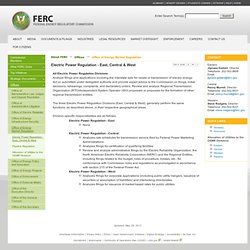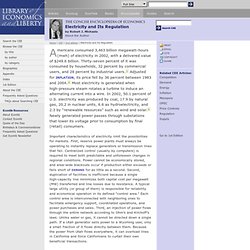

A Historical Perspective of Electric Power Regulation. There was a time prior to the year 1900 when electric power generation was privately own and essentially free from political regulation.

The development of the electric light bulb and the electrically powered streetcar encouraged the development of large-scale electric power generation. At the time, large reciprocating steam piston engines were already well proven in marine and railway transportation while hydraulic river turbines were well proven at mills and factories located along rivers and streams. The engines and technologies were easily adapted to driving electrical generators. When potential investors were convinced that there was potential to install viable hydraulic power generation at Niagara Falls to supply power to markets at New York City, the project went ahead. By 1890, incandescent electric lights lit up the night at NYC and horse-drawn streetcars and were converted to electric propulsion in many cities around the world. Alternative Scenario: Conclusions: Regulation and Oversight of the Electric Power Industry - Compete Coalition.
About FERC - Electric Power Regulation - East, Central & West. Offices Office of Energy Market Regulation Electric Power Regulation - East, Central & West All Electric Power Regulation Divisions Analyze filings and applications involving the interstate sale for resale or transmission of electric energy.

Act on submittals under delegated authority and provide expert advice to the Commission on filings, initial decisions, rehearings, complaints, and declaratory orders. Review and analyze Regional Transmission Organization (RTO)/Independent System Operator (ISO) proposals or proposals for the formation of other regional transmission entities. The three Electric Power Regulation Divisions (East, Central & West), generally perform the same functions, as described above, in their respective geographical areas. Division-specific responsibilities are as follows: Electricity and Its Regulation. Americans consumed 3,463 billion megawatt-hours (mwh) of electricity in 2002, with a delivered value of $249.6 billion.

Thirty-seven percent of it was consumed by households, 32 percent by commercial users, and 28 percent by industrial users. Adjusted for inflation, its price fell by 36 percent between 1983 and 2004. Most electricity is generated when high-pressure steam rotates a turbine to induce an alternating current into a wire. In 2002, 50.1 percent of U.S. electricity was produced by coal, 17.9 by natural gas, 20.2 in nuclear units, 6.6 as hydroelectricity, and 2.3 by “renewable resources” such as wind and solar. Newly generated power passes through substations that lower its voltage prior to consumption by final (retail) consumers.
Important characteristics of electricity limit the possibilities for markets. Electricity’s ownership structure is complex. By the 1970s, the good times were over. At about this time, regulators, consumers, and utilities began reconsidering markets. ESD.934 Engineering, Economics and Regulation of the Electric Power Sector, Spring 2010. Electric Power Sector. Federal Energy Regulatory Commission. Federal Energy Regulatory Commission. The Federal Energy Regulatory Commission (FERC) is the United States federal agency with jurisdiction over interstate electricity sales, wholesale electric rates, hydroelectric licensing, natural gas pricing, and oil pipeline rates.

FERC also reviews and authorizes liquefied natural gas (LNG) terminals, interstate natural gas pipelines and non-federal hydropower projects. The top priorities in 2014 include: natural gas - electric coordinationsmart griddemand responseintegration of renewablesOrder No. 1000 - transmission planning and cost allocation[1] History[edit] The Federal Power Commission (FPC), which preceded FERC, was founded in 1930 to allow cabinet members to coordinate federal hydropower development. In 1935, the FPC was transformed into an independent regulatory agency with five members nominated by the President and confirmed by the Senate. In 1938, the Natural Gas Act gave FPC jurisdiction over interstate natural gas pipelines and wholesale sales. Commissioners[edit]